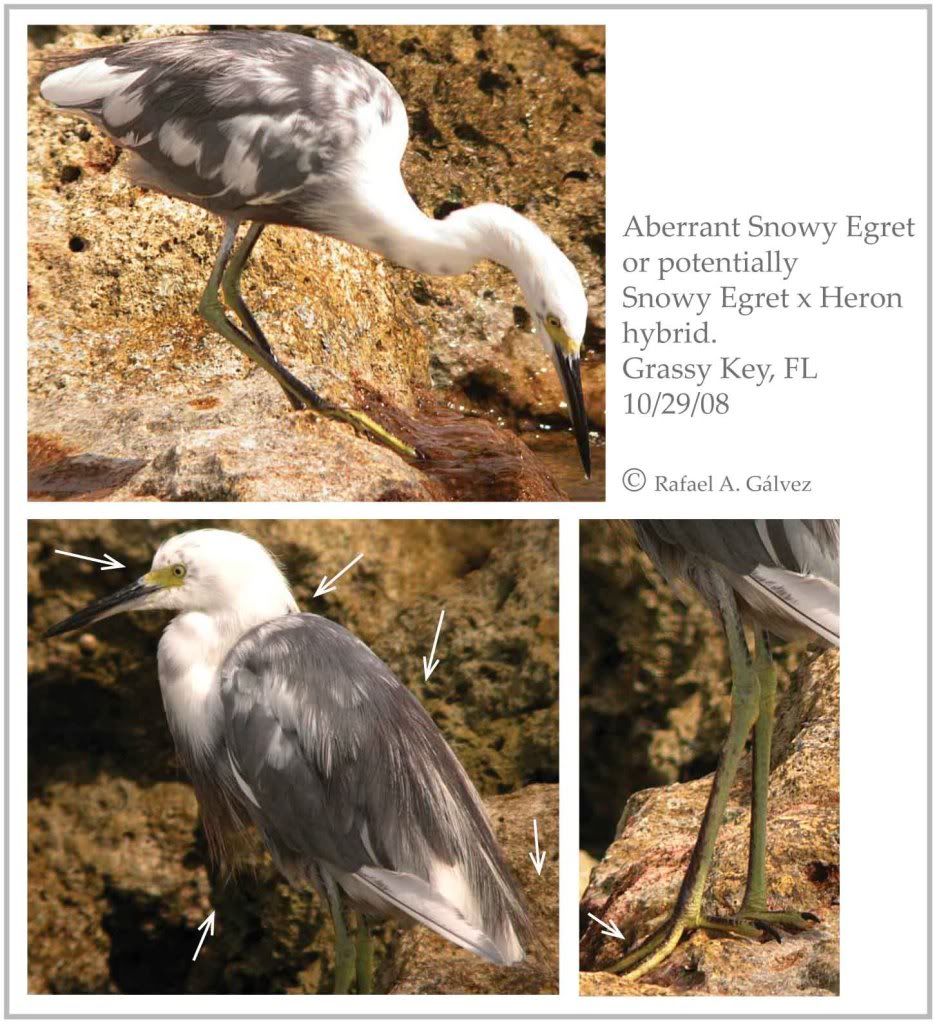
[ Follow Ups ] [ Post Followup ] [ TAS BirdBoard ] [ FAQ ]
Posted by Rafael Gálvez on 13:00:20 10/31/08

An aberrant Snowy Egret or probable Snowy Egret x Heron hybrid was observed and photographed in Marathon, along the Key Colony Beaches on 10/29/08.
After years of doing wading bird surveys, we tend to glance over large groups of herons and egrets, quickly categorizing birds under some recognized form. At a distant glance, this bird momentarily appeared to be a juvenile Little Blue Heron phasing to dark adult plumage, but the mirage was quickly shaken. After a longer pause, it was readily noticeable that this bird was a juvenile Snowy Egret at its core. Revelatory marks included: yellow lores, pale inner-half or lower mandible, dark forelegs, and slender bill.
Aberrant Snowy Egrets with dark plumage are not well known, and unlike similar-sized Little Blues, Snowy Egrets do not show color variation with age. However, various cases of Snowy Egret hybrids with other heron species are well documented. In size and proportions, the Snowy perhaps approaches Little Blue Herons most, but this does not keep the small white egret from hybridizing with Tricolored Heron (Dickerman and Parks 1968; Meeks et al. 1996), Cattle Egret (Parkes 1978; Paul and Schnapf 1998), Little Egret, as well as Little Blue Heron (Sprunt 1954; Kaufmann 1990; Martinez-Vilalta and Motis 1992).
Aside from the odd dark plumage, some details in this bird s appearance make hybridization a possibility. Overall the bird has all the tell-tale marks of a normal Snowy: lacy aigrette plumes draping over the back, mantle and tertials; long plumes hanging from the breast; and lacy plumes congregating at the nape (perhaps not fully developed due to age). In general, the bare parts show the marks of a juvenile Snowy, including the greenish coloration of the legs.
Where we start running into some trouble is in the appearance of the feet. Although the under-toes are distinctly yellow, as would be expected from a Snowy, the upper surface of the toes is dark and this is a true anomaly for this species. A Snowy egret with dark toes is a conflicted bird, because this species feeds primarily by a combined technique of foot shaking and running pursuit. The Snowy shakes its distinctly yellow toes in shallow waters causing prey to flee from hiding nooks under the surface, after which the egret chases and darts with agility and precision. It has been argued that without yellow feet, this technique (which is quite particular to Snowy and absent from Tricolored and Little Blue) would be unsuccessful; the bright yellow toes would appear a bolder menace under murky waters.
Perhaps the dark toes would explain the reason why the bird foraged rather like a Little Blue Heron, making slow movements towards the water s edge and freezing for long periods with its bill angled to the water. Additionally, strands of subtle purple and golden hues were present on the dark mantle plumes, and on the breast, reminiscent of coloration found on Tricolored Herons. It should be noted that the combination of pale blue-green legs, pale toes, and dark forelegs and upper feet surfaces are not unknown in Tricolored Egrets; during a visit to Chekika ENP on 10/30/08 I found dozens of Tricolored Herons feeding, some (adults and juveniles) of which wore this particular leg combination.
Any comments would be appreciated. Don t assume a pied small heron to be what you always expect!
Thanks A & M for link.
[ Follow Ups ] [ Post Followup ] [ TAS BirdBoard ] [ FAQ ]